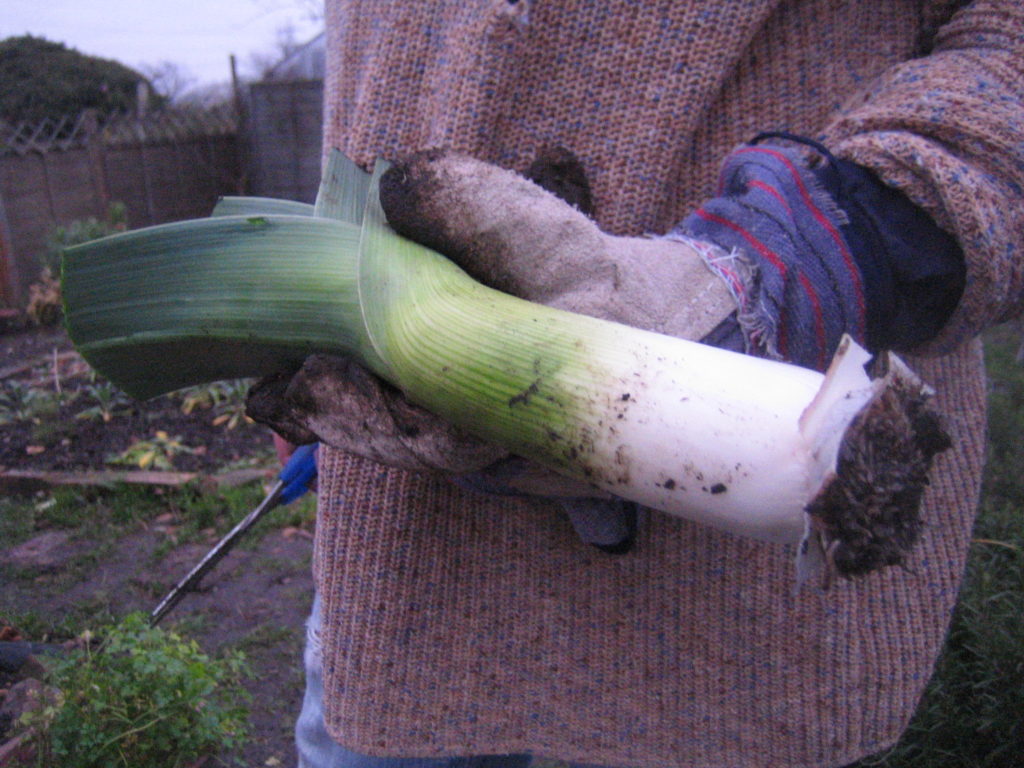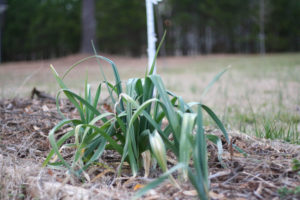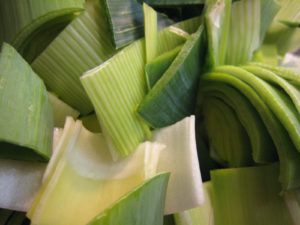About Leeks
Leeks are a traditional vegetable, grown and harvested since ancient times. They originated in Asia but have been used in the west before Roman times. They are the national vegetable of Wales! Leeks are Alliums, related to both garlic and onions. These delicious plants are often sliced and used raw as a garnish or in salads and are commonly used in soups or sautéed with mushrooms. They can be an alternative to onions or scallions in any recipe. They are strong tasting vegetables, but usually mild compared to true onions.
The two main varieties of leeks are the “Early season” and “Late season” types. The early season varieties are easier to plant and harvest, and they mature more quickly, usually about 2 to 3 months after you plant them. These perform better in slightly more temperate areas. Late season leeks take longer, 5 or 6 months (or even 7). They are stronger tasting, but the flavor can be made milder by blanching them. Blanching is done by hilling the dirt around them or wrapping the stems as they grow, to protect them from sunlight. These grow well in both temperate and cold climates.
Leeks are very healthy too! They are a great source of vitamin K, and are high in vitamins B6 and C, and are a good source of iron, copper, manganese, and folate. They are also high in carotenoids, as well as antioxidants such as kaempferol, which may act as an anti-diabetic, reducing blood sugar.
How to Grow Leeks
- Leek (Allium porrum)
- Perennial, grown usually as an annual
- Full sun
- Soil should be near neutral (6.0 to 7.0 pH)
- Well-drained rich warm soil
- Garden planting:
Start indoors in February or March in cooler climates
Start outdoors after last frost
Transplant at about 6-8 weeks after starting (4-6″ tall).
Plant leeks 6 inches apart
Keep garden rows 18 inches apart
- Container planting:
Single plants in 18″ deep containers, filled about 2/3 with soil, fill in as the leek grows.
- Water thoroughly at least 1 inch per week
- Climate Zones 5-9

Leeks are best started indoors and transplanted to the garden when they are about 4 to 6 inches tall, after the last frost. Harden the plants a few weeks before transplanting, by moving them outdoors for a few hours a day. Ensure that the garden soil is fertile and well drained. Dig holes into the soil, each about the same size as an individual leek plant. These should be spaced six inches apart, and if there are rows, keep the rows 18 inches apart. A common method, that keeps the leeks blanched, is to plant them in furrows, and gradually raise the level of soil, keeping the base of the plant covered. Another way is to plant them at ground level and build a low mound of soil and mulch around each plant as it grows.
Leeks are pretty frost resistant. The early season leeks less so, but even these can be harvested into the late fall, and can withstand a mild frost or two before winter sets in. The late season varieties are much hardier in cold temperatures, and some can even be harvested after the winter in the early spring, if the winter is not too severe. A mound at the base of the plant is not only good for blanching, it can help protect the stalk from freezing weather as well.
Leeks can also be grown in pots! You can start a few leeks in smaller pots, and transplant them each to a larger pot when they get big enough. The final container should be large, about 18 inches deep, and it’s often best to keep one plant per pot. Some growers have had success with growing multiple plants in a larger pot, but my success with this has been with individual pots for each leek. It’s a good idea to transplant the seedling into the larger pot and leave several inches of space above the soil in the container. As the plant grows, you can add potting soil around the base of the leek, just like you would in a garden furrow, until the planter soil is level with the top. Then, as the plant matures, keep the stalk covered with paper, or even a cardboard tube, to ensure it stays blanched as it grows to full maturity.
Leek Pests and Diseases

Common pests for leeks include the onion maggot, leek moths, (or onion leaf miners), and onion thrips. an onion maggot is a larva from eggs left by a small gray flying insect, the onion fly. It lays its eggs around the base of the plant. The hatching larvae will dig into the leeks. This will cause seedlings to wilt, and older plants to grow badly and turn gray. Leek moths are larvae from a yellow and black flying insect that lays its eggs on the leaves of the plant. These will also bore into the plant, causing white spots and dying leaves. Thrips will cause the growth of the plant to be stunted, and the leaves and stems may be discolored. Mostly, these can be avoided by keeping the garden carefully weeded and by planting companions that these insects avoid. If these pests become a problem, neem oil is a good organic treatment for all of these.
The best companion plant for leeks is carrots. Carrots and leeks repel each other’s pests pretty well. Onion flies and leek moths dislike carrots and will avoid areas where they are planted. Leeks return the favor for carrots by keeping carrot rust flies away. Leeks also do well as companions for tomatoes, peppers, and beets, by keeping aphids and other pests away from these plants.
Leek diseases can include leaf blight, leek rust, and downy mildew. Leaf blight is a fungal disease that causes white spots on the leaves. Leek rust is a common disease for leeks that also affects their relatives, onions and garlic. It will show as orange spots on both sides of the leaf. Downy mildew will cause pale streaks on the leaves, and may show up as a purplish growth, as well. The leaves will turn yellow, and wilt. Regular crop rotation is always the best thing to prevent recurring fungal diseases. Good spacing is important as it gives the leeks good air circulation and the ability to dry off after watering or a good rain. If needed, a strong sulfur fungicide, or applications of neem oil are both good ways to keep these fungi under control.
How to Harvest Leeks

Harvesting leeks is an easy process. Gently remove the entire plant from the soil, digging under it if needed. Trim off the roots and any leaves that show damage, and it’s ready for the kitchen! Harvest whenever the roots are thick enough to use. In the coldest climates, it is best to harvest the leeks before the ground freezes completely.
The leek seeds can be harvested by waiting until the flowers are browned and completely dry, and a bit brittle. The timing depends on the variety, but they will be ready once the plant is fully mature. Trim two or three dry flowers off the plants and put them in a bag to avoid losing seeds. Over a container or a platter, pull off the seeds and carefully roll them between your fingers, to separate them from the foliage and husks. Save the dark black seeds for future use!
If you’re looking to include leeks in your garden, try our garden planner Hortisketch, so you can design and plan your garden before you commit trowel to soil.











